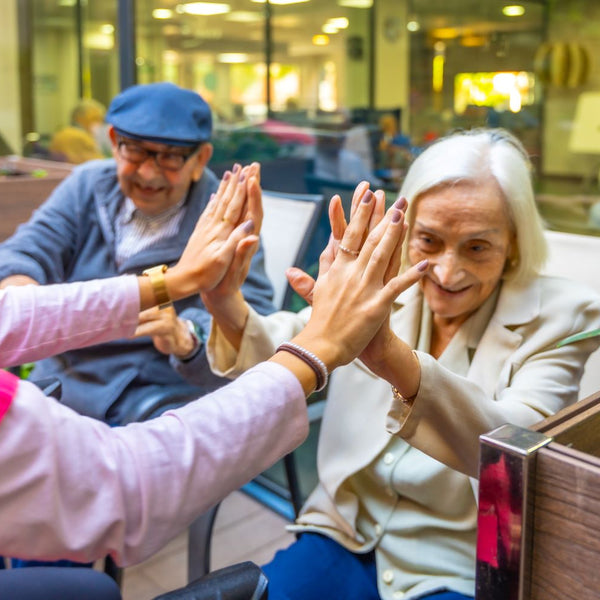Participating in art and craft activities can be very beneficial at any stage of life, but many older people find that it is not only enjoyable and a great way to express themselves, but can also have a real impact on their health, wellbeing and quality of life too.
In this article, we look at why arts and crafts can be beneficial for those in later life, the positive effects on physical and mental health, and suggest some great activities and projects for older people to try.
Jump to:
- What are the benefits of arts and crafts for the elderly?
- Popular crafts for elderly people
- Popular art activities for older adults
- Arts and crafts for the elderly with dementia
- Multi-generational arts and crafts
- Peace of mind when older adults are crafting or creating art
What are the benefits of arts and crafts for the elderly?
There are many different potential benefits of participating in arts and crafts for the elderly, even if it involves them trying some activities for the first time. Some of the many benefits include:
Providing a creative outlet
Participating in arts or crafting provides a creative outlet for elderly people and can help them express their thoughts and feelings, along with creating something tangible that has meaning for them. It’s not about making a piece or item that is perfect or them being highly skilled, it’s about trying new things and learning along the way. There is no right or wrong way to be creative; it’s all about taking part and giving it a go.
Improving mood and mental wellbeing
Spending some time focused on a creative task or activity is known to improve mood and sense of wellbeing, with arts and crafts being one way that many people manage their emotions, as well as expressing things that they might find difficult or be unable to vocalise.
Creating art or crafting can help to reduce stress, anxiety and negative feelings, both by acting as a distraction and also by providing some head space while focusing on the task. Many people find activities like this to be very calming, as well as confidence-building.
Improving or maintaining motor skills and dexterity
As well as mental and emotional benefits, participating in arts and crafts can help older adults to use their hands and arms more, and in different ways to with other normal daily tasks. This can improve blood flow, build and maintain muscle strength and improve dexterity. Many older people experience arthritis pain in their hands or wrists, and regular movements when doing artistic or crafting activities can help to control pain and swelling.
Improving cognitive function
Creating something, whether it’s through art or a craft, provides a challenge, which can be very stimulating for the brain. It’s common for people to feel that their brain slows down somewhat during later life, so taking part in creative activities that help their mind to continue to adapt and overcome challenges can be very beneficial.
Providing opportunities for socialising
While many art and crafting activities can be carried out solo, they certainly don’t have to be. Many older people struggle with feeling isolated and lonely, and finding other people who also like similar art activities or a particular craft can provide great opportunities to meet new people and make new friends with a common interest. Whether it’s a local knitting group that meet in a community space, an art or pottery class, or even an online group that has regular video call meetups, it can all have a positive impact on the life of older people who may be missing social opportunities otherwise.
Popular crafts for elderly people

We have picked just a few of the many popular crafts that many elderly people enjoy doing. Some require more or less detailed work and fine motor skills than others, so there should be something for everyone. None of these crafts require lots of costly materials to start or learn.
Sewing – Using hand-sewing techniques with minimal equipment needed, or using a sewing machine if available, older people can create almost anything with fabric, scissors, needle and thread. From pillowcases or cushion covers to curtains, clothes or accessories, the possibilities are almost endless.
Knitting – Using wool and a pair of knitting needles, even beginners can quickly learn how to knit items such as hats, scarves and blankets. More challenging knitting projects can include jumpers, gloves and tea cosies, amongst others.
Crocheting – A form of knitting that involves using a hook with wool rather than needles, basic crocheting can be learned quickly and some straightforward projects include anything from drinks coasters to hats, blanket squares, mug cosies, bags and cushion covers.
Cross stitch – Inexpensive cross stitch kits are available which enable anyone to create hand-embroidered pieces, following a provided pattern, which could be used as anything from framed pieces to be hung on the wall to cushion covers, bags or bookmarks.
Needle felting – Using a felting needle and carded wool or a type of wool called roving, needle felting is the process of using wool fibres to build up gradually into 3D felted figures. It’s not particularly difficult to do but does take a long time and the needle used is very sharp, so may be more suited to those with a good level of dexterity in their hands.
Card making – Using cardstock, paper and embellishments such as dried flowers, stickers, ribbon or drawings, creating greetings cards can be a great creative activity for older adults.
Clay modelling – using polymer clay (which can be baked in a household oven) or air-dry clay (which only needs air and time to harden) so that no kiln is needed. The types of projects that are very popular with clay modelling for beginners include making jewellery or beads, bookmarks, fridge magnets and Christmas tree ornaments.
Popular art activities for older adults
For older adults who want to try art activities, we’ve compiled some common types of art that don’t need much equipment or materials to start, and need absolutely no experience with painting or art.
Adult colouring – An activity that millions of adults find therapeutic, adult colouring books are inexpensive and readily available, along with some colouring pencils. This is an activity that can be picked up anytime and there are books with larger print available for those who might have some impaired vision.
Glass painting – An activity that just requires some glass paints (also available in pens, which are even easier to apply) and even beginners can quickly turn plain drinks tumblers into beautiful drinks glasses or old jars into decorative feature lights, with some battery-operated fairy lights.
Rock painting – A fun art activity for the oldest to the youngest, rock painting simply needs some small, clean and smooth rocks and some acrylic paints (also available in pens), which are inexpensive and widely available. Painting simple designs on rocks is only half the fun though. Hiding the now-painted rocks outside for children or others in the community to find is also a great idea.

Arts and crafts for the elderly with dementia
Research indicates that there is a strong link between creative activities and benefits for people experiencing dementia. With everything from painting or crafting to listening to music being very stimulating for the brain, this can help some people with dementia with areas such as communication, self-expression, stress relief and connecting with the world in different ways.
If they used to have creative hobbies in the past, picking these up again, if appropriate, can also help them to make more connections in regular activities, may spark some nostalgia or long-term memories and could help improve their enjoyment or quality of life.
Multi-generational arts and crafts
Not only can participating in arts and crafts be beneficial to the elderly person involved, it’s also something that multiple generations can get involved in and do together. This is a great way for different generations within families to spend time and make some memories together, focusing on a creative task and learning together to create something that can be kept and treasured.
Most of the craft and art activities covered in this article can be done by anyone from young children (under supervision) to the very eldest family member or friend.
Take a look at more beneficial hobbies and interests for older adults which family members and friends can also get involved with.

Peace of mind when older adults are crafting or creating art
Whether your older loved one is enjoying arts and crafts at home or is out and about at various groups, workshops or classes, it can be easy to worry about them when you’re not there. Would they be able to get help if they had a fall or another kind of accident?
One solution that can provide real peace of mind and confidence in living a fuller and more independent life for older adults is a personal alarm system with emergency button. Designed to be worn at all times, so that assistance can be reached with just the press of a single button, personal alarms for the elderly come with various different features so that you can choose one that is ideally matched to the lifestyle of an older adult in your life.
Whether it’s elderly fall alerts to automatically detect when the wearer has a fall, or a non-intrusive smart home monitoring system that detects when your loved one’s routine unexpectedly changes, Taking Care has a solution to help support every older person living independently at home.
If you’d like to find out more about our products and their features so that you can choose the ideal system for your older loved one, get in touch with our team by calling 0800 0121 321.




